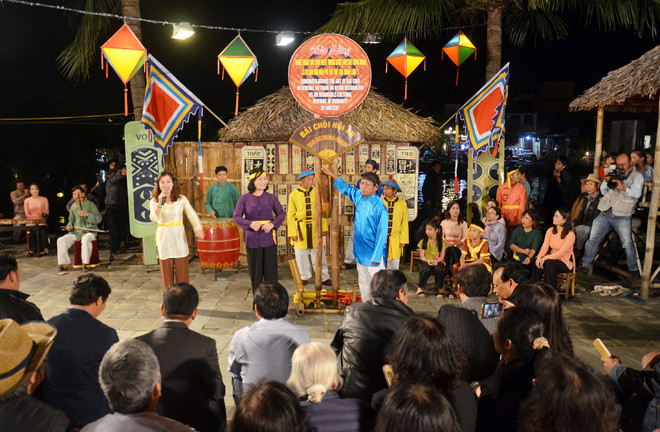(TITC) - Bai Choi is a diverse art form combining music, poetry, stage acting, painting and literature and expressing the life, mind and emotion of people in Central Viet Nam. According to Bai Choi artists, this type of art originated from the need of entertainment and exchange by songs among the huts in the fields. Now, the art of Bai Choi is a common heritage of 9 provinces/city in Central Viet Nam, including Quang Binh, Quang Tri, Thua Thien - Hue, Da Nang, Quang Nam, Quang Ngai, Binh Dinh, Phu Yen and Khanh Hoa.

(Source: VOV)
Characteristics
The art of Bai Choi is a funny and intellectual folk game and also contains impromptu creativeness. It takes two main forms, namely Bai Choi games and Bai Choi performance. Bai Choi games are played during Lunar New Year by people of Central Viet Nam. To play Bai Choi, nine or eleven bamboo huts are built in a U-shape within a temple yard or in a vacant ground. The hut placed at the bottom of the U shape is called “main hut” (choi cai), and the game leaders, who can be either male or female, are called Hieu artists. Players buy three cards and wait in the hut. The game leader takes a card out of a tube of cards, and then sings for people to guess what the card is. This part is called “Ho Thai”. Anyone whose three cards match the cards sung by the Hieu artists will be declared the winner and given the prize.
In Bai Choi performance, Hieu artists either travel from place to place to perform, or otherwise are invited to play for private families, forming rattan-peforming or mobile Bai Choi styles. They perform on a rattan mat. A single artist may also perform “solo Bai Choi”. In this case, the artists performs a number of theatrical roles. They have skills at improving poems on the spot and transforming folk stories into sung phrases. Bai Choi songs include lessons on morality, compassion, as well as love for the village, nation and national unity.
The art of Bai Choi exhibits three distinct music styles which are specific to three areas in Central Viet Nam. Bai Choi tends to be: “slower” and more “simple” in the area of Quang Binh, Quang Tri and Thua Thien-Hue; “gentle”, “lyrical” and “light and flowing” in Quang Nam, Quang Ngai, and Da Nang; and more “dramatic” in Binh Dinh, Phu Yen and Khanh Hoa.
The people who maintain, practise and transmit the art of Bsi Choi are: Hieu artists, card-making folk artists, hut-making folk artists who participate in the Bai Choi game, and solo Bai Choi performers.
Outstanding Values
The art of Bai Choi is an important form of culture and recreation within the village community, providing entertainment as well as a context for socialising and enjoyment of the arts. Bai Choi performances are tragicomic, providing a humorous commentary on life in general and on bad habits, which enable audiences to both reflect and laugh.
Bai Choi activities provide a context for artistic creativity, while at the same time preserving the folk art, performing styles and cultural values of each region. The cultural and artistic elements in Bai Choi, which include poetry, music, painting, language and customs, are naturally and simply transmitted to audiences in a way that easily grabs attention, becoming a popular and essential cultural activity in Central of Viet Nam.
With its ability to transmit knowledge of folklore through games and performances, Bai Choi is an important form of community activity with educational value for younger generations.
The preparation and organisation of Bai Choi performances brings people together artists and members of the community. This creates an opportunity for artists to exchange different performance styles, and connects Bai Choi practitioners with each other and with their audiences. Members of the community have a chance to understand folklore and to share their feelings, knowledge and life experiences with each other.
Practicing the Art of Bai Choi
According to the inventory result of 2014, there are 1,376 people (870 males and 506 females) in 86 teams, groups and clubs practising Bai Choi in 9 provinces/city of Quang Binh, Quang Tri, Thua Thien - Hue, Da Nang, Quang Nam, Quang Ngai, Binh Dinh, Phu Yen, and Khanh Hoa. In Binh Dinh and Quang Ngai provinces, Bai Choi has strongly developed with 37 clubs, 27 families and 106 folk artists practising Bai Choi and these areas exert a large influence on the other seven provinces.
On 7 December 2017, at the 12th session of the Intergovernmental Committee for the Safeguarding of the Intangible Cultural Heritage of UNESCO held in Jeju, the Republic of Korea, the art of Bai Choi in Central Viet Nam was recognized as Intangible Cultural Heritage of Humanity.
Tourism Information Technology Center